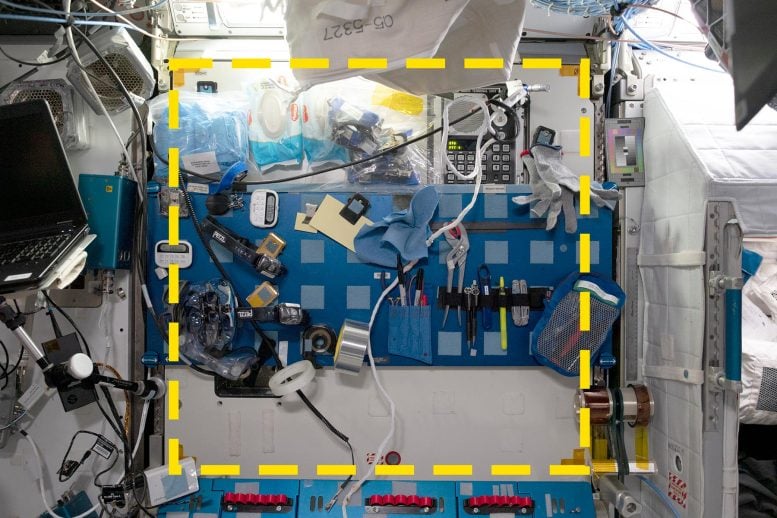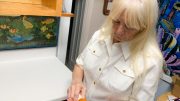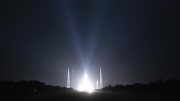
A sample location from the Sampling Quadrangle Assemblages Research Experiment (SQuARE), Square 03 in the starboard Maintenance Work Area of the International Space Station. An open crew berth is visible at right. The yellow dotted line indicates the boundaries of the sample area. Credit: NASA/ISSAP
Discrepancies found between intended and actual use of certain areas aboard the space station.
Using daily photos to study the International Space Station, researchers have discovered that astronauts use the space differently from its intended design. The study highlights areas where everyday items are repurposed, providing valuable lessons for designing future space habitats.
An archaeological strategy adapted for space used daily photos to reveal how astronauts actually use areas aboard the International Space Station – and how this differs from intended uses. Justin Walsh of Chapman University, California, and colleagues present these findings today (August 7) in the open-access journal PLOS ONE.
ISS as a Microsociety: A Novel Archaeological Approach
More than 270 people from 23 countries have visited the International Space Station (ISS) over more than two decades. Crew member interviews can reveal how people adapt to a novel environment—one featuring isolation, confinement, and microgravity—that is far removed from the context in which humans evolved. However, interviews may be unable to capture insights that could be captured by alternative approaches.
In order to better understand the “microsociety” of the ISS, Walsh, and colleagues launched the International Space Station Archaeological Project, which applies an archaeological framework to the ISS and studies the materials used by its crew as artifacts.
For their first direct work on the space station, the team adapted a traditional archaeological strategy known as the shovel test pit, in which small pits are dug at intervals across a site to assess artifact distribution and select areas for more extensive excavation. In this case, the archaeologists asked the ISS crew to document six locations around the station, and instead of digging pits, taking daily photos of each location for 60 days in 2022.
Unconventional Findings From Space Station’s Daily Life
The new article reveals findings from the first two of the six sample areas to be fully documented: one designated for equipment maintenance and another near the latrine and exercise equipment. Further analysis of photos in these areas using a novel open-source image analysis platform developed by the team revealed 5,438 instances of “artifacts” being used for varied purposes, such as writing tools, Post-It notes, and an augmented reality headset.
Cross-referencing the photos with astronaut activity reports, the researchers found that the area near the exercise equipment and latrine, while not designated for any particular purpose, had been used as storage for toiletries, resealable bags, and a rarely used computer. The equipment maintenance area was used primarily for storage, with little or no maintenance actually carried out there.
Adapting Archaeology for Space Exploration’s Future
These findings demonstrate how traditional archaeological techniques can be adapted to study remote or extreme habitats. The findings could also help inform development of future space habitats.
The authors add: “The experiment is the first archaeology ever to happen off of the planet Earth. By applying a very traditional method for sampling a site to a completely new kind of archaeological context, we show how the ISS crew uses different areas of the space station in ways that diverge from designs and mission plans. Architects and planners of future space stations can learn valuable lessons from this work.”
Reference: “Archaeology in space: The Sampling Quadrangle Assemblages Research Experiment (SQuARE) on the International Space Station. Report 1: Squares 03 and 05” by Walsh JSP, Graham S, Gorman AC, Brousseau C, Abdullah S, 7 August 2024, PLOS ONE.
DOI: 10.1371/journal.pone.0304229
Justin Walsh was the recipient of funding from Chapman University’s Office of Research and Sponsored Programs to support the activities of Axiom Space as an implementation partner for the research presented in this article. There are no associated grant numbers for this financial support. Axiom Space served in the role of a contractor hired by Chapman University for the purpose of overseeing logistics relating to our research. In-kind support in the form of ISS crew time and access to the space station’s facilities, also awarded to JW from the ISS National Laboratory, resulted from an unsolicited proposal, and therefore there is no opportunity title or number associated with our work. No salary was received by any of the investigators as a result of the grant support. No additional external funding was received for this study.









Be the first to comment on "Space Archaeology: Astronauts’ Secret Habits Caught on Camera"